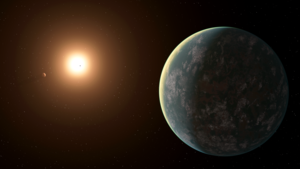கிளீசே 357
| நோக்கல் தரவுகள் ஊழி J2000 Equinox J2000 | |
|---|---|
| பேரடை | Hydra |
| வல எழுச்சிக் கோணம் | 09h 36m 01.63722s[1] |
| நடுவரை விலக்கம் | -21° 39′ 38.8776″[1] |
| தோற்ற ஒளிப் பொலிவு (V) | 10.906[2] |
| இயல்புகள் | |
| விண்மீன் வகை | M2.5V[3] |
| வான்பொருளியக்க அளவியல் | |
| ஆரை வேகம் (Rv) | −35.03±0.17[1] கிமீ/செ |
| Proper motion (μ) | RA: 138.722±0.023 மிஆசெ/ஆண்டு Dec.: −990.342±0.020 மிஆசெ/ஆண்டு |
| இடமாறுதோற்றம் (π) | 105.9789 ± 0.0227[1] மிஆசெ |
| தூரம் | 30.776 ± 0.007 ஒஆ (9.436 ± 0.002 பார்செக்) |
| தனி ஒளி அளவு (MV) | +11.13[4] |
| விவரங்கள் | |
| திணிவு | 0.362[5] M☉ |
| ஆரம் | 0.333[4] R☉ |
| மேற்பரப்பு ஈர்ப்பு (மட. g) | 4.96[5] |
| ஒளிர்வு | 0.014[6] L☉ |
| வெப்பநிலை | 3,488[5] கெ |
| சுழற்சி | 74.3±1.7 d[7] |
| சுழற்சி வேகம் (v sin i) | 2.5[5] கிமீ/செ |
| வேறு பெயர்கள் | |
| தரவுதள உசாத்துணைகள் | |
| SIMBAD | data |
கிளீசே 357 (Gliese 357) ( 357 GJ 357எனவும் அழைக்கப்படுகிறது) என்பது வழக்கத்திற்கு மாறாக குறைந்த கரும்புள்ளிச் செயல்பாட்டைக் கொண்ட M-வகை முதன்மை வரிசை விண்மீனாகும் . [8] இது சூரிய குடும்பத்தில் இருந்து 31 ஒளி ஆண்டுகள் தொலைவில் அமைந்துள்ளது. இந்த அமைப்பு நீர்பாம்பு விண்மீன் தொகுப்பின் ஒரு பகுதியாகும். [9]
கோள் அமைப்பு[தொகு]
விண்மீன் தன் வட்டணையில் மூன்று உறுதிப்படுத்தப்பட்ட புறக்கோள்களைக் கொண்டுள்ளது, [10] அவற்றில் ஒன்று, கிளீசே 357 டி, சுற்றுச்சூழலின் வாழக்கூடிய மண்டலத்திற்குள் உள்ள " மீப்புவி " என்று கருதப்படுகிறது. [11] [9] [12] [13]
கிளீசே 357 b, 357 c கோள்கள் 3:7 சராசரி இயக்க ஒத்திசைவுக்கு அருகில் உள்ளன. ஒத்திசைவுத் தொடர் வெளிப்புற, குளிர்ந்த மீப்புவி ஒத்த கோள்களில் இருந்து கிளீசே 357 d இடைவெளியையும் கடக்கிறது. ஒத்திசைவுகள் எளிமையானவை, கிளீசே 357 தோராயமாக வாழ்வதற்கு மிகவும் பொருத்தமான கோளைக் கொண்டிருக்கலாம். இதன் வட்டணைக் காலம்27.5 நாள். இது கிட்டத்தட்ட புவியினை ஒத்த பாயம், செவ்வாய் அளவுக்கும் குறைவாக கோள் 2:1 வட்டணைக் கால விகிதத்தில் GJ 357 சி கோளையும் 2:3 வட்டணைக் வ்கால விகிதத்தில் கருதுகோள்நிலை HZ பாறைக்கோள் ஒன்றையும் சுற்றிவரலாம்.
| துணை (விண்மீனில் இருந்து) |
திணிவு | அரைப்பேரச்சு (AU) |
சுற்றுக்காலம் (நாட்கள்) |
வட்டவிலகல் |
|---|---|---|---|---|
| b | 1.84±0.31 M⊕ | 0.035±0.002 | 3.93072+0.00008 −0.00006 |
0.047+0.059 −0.047 |
| c | ≥3.40±0.46 M⊕ | 0.061±0.004 | 9.1247+0.0011 −0.0010 |
0.072±0.053 |
| d | ≥6.1±1.0 M⊕ | 0.204±0.015 | 55.661±0.055 | 0.033+0.057 −0.033 |
மேற்கோள்கள்[தொகு]
- ↑ 1.0 1.1 1.2 1.3 Vallenari, A. et al. (2023). "Gaia Data Release 3. Summary of the content and survey properties". Astronomy and Astrophysics 674: A1. doi:10.1051/0004-6361/202243940. Bibcode: 2023A&A...674A...1G. Gaia DR3 record for this source at VizieR.
- ↑ Koen, C.; Kilkenny, D.; Van Wyk, F.; Marang, F. (2010). "UBV(RI)C JHK observations of Hipparcos-selected nearby stars". Monthly Notices of the Royal Astronomical Society 403 (4): 1949. doi:10.1111/j.1365-2966.2009.16182.x. Bibcode: 2010MNRAS.403.1949K.
- ↑ Gray, R. O.; Corbally, C. J.; Garrison, R. F.; McFadden, M. T.; Bubar, E. J.; McGahee, C. E.; O'Donoghue, A. A.; Knox, E. R. (2006). "Contributions to the Nearby Stars (NStars) Project: Spectroscopy of Stars Earlier than M0 within 40 pc-The Southern Sample". The Astronomical Journal 132 (1): 161–170. doi:10.1086/504637. Bibcode: 2006AJ....132..161G. https://archive.org/details/sim_astronomical-journal_2006-07_132_1/page/161.
- ↑ 4.0 4.1 Houdebine, E. R.; Mullan, D. J.; Paletou, F.; Gebran, M.; Bubar, E. J.; McGahee, C. E.; O'Donoghue, A. A.; Knox, E. R. (2016). "Rotation-Activity Correlations in K and M Dwarfs. I. Stellar Parameters and Compilations of v sin I and P/Sin I for a Large Sample of Late-K and M Dwarfs". The Astrophysical Journal 822 (2): 97. doi:10.3847/0004-637X/822/2/97. Bibcode: 2016ApJ...822...97H.
- ↑ 5.0 5.1 5.2 5.3 Passegger, V. M.; Reiners, Ansgar; Jeffers, S. V.; Wende-von Berg, S.; Schöfer, P.; Caballero, J. A.; Schweitzer, A.; Amado, P. J. et al. (2018). "The CARMENES search for exoplanets around M dwarfs. Photospheric parameters of target stars from high-resolution spectroscopy". Astronomy and Astrophysics 615: A6. doi:10.1051/0004-6361/201732312. Bibcode: 2018A&A...615A...6P.
- ↑ Morales, J. C.; Ribas, I.; Jordi, C.; McFadden, M. T.; Bubar, E. J.; McGahee, C. E.; O'Donoghue, A. A.; Knox, E. R. (2008). "The effect of activity on stellar temperatures and radii". Astronomy and Astrophysics 478 (2): 507. doi:10.1051/0004-6361:20078324. Bibcode: 2008A&A...478..507M.
- ↑ Suárez Mascareño, A.; Rebolo, R.; González Hernández, J. I.; Esposito, M. (2015), "Rotation periods of late-type dwarf stars from time series high-resolution spectroscopy of chromospheric indicators", Monthly Notices of the Royal Astronomical Society, 452 (3): 2745–2756, arXiv:1506.08039, Bibcode:2015MNRAS.452.2745S, doi:10.1093/mnras/stv1441
- ↑ Modirrousta-Galian, D.; Stelzer, B.; Magaudda, E.; Maldonado, J.; Güdel, M.; Sanz-Forcada, J.; Edwards, B.; Micela, G. (2020), "A Super-Earth Orbiting an Extremely Inactive Host Star", Astronomy & Astrophysics, p. 641, arXiv:2007.10262, doi:10.1051/0004-6361/202038280
{{citation}}: Missing or empty|url=(help) - ↑ 9.0 9.1 Reddy, Francis (2019-07-31). "TESS Discovers Habitable Zone Planet in GJ 357 System". பார்க்கப்பட்ட நாள் 2019-08-01.Reddy, Francis; Center, NASA’s Goddard Space Flight (2019-07-31).
- ↑ "The Extrasolar Planet Encyclopaedia — Gj 357 b". பார்க்கப்பட்ட நாள் 2019-08-01.
- ↑ Falconer, Rebecca, Newly uncovered super-Earth 31 light-years away may be habitable, Axios, August 1, 2019
- ↑ "Potentially habitable 'super-Earth' discovered just 31 light-years away". பார்க்கப்பட்ட நாள் 2019-08-01.
- ↑ Garner, Rob (2019-07-30). "NASA's TESS Helps Find Intriguing New World". பார்க்கப்பட்ட நாள் 2019-08-01.
- ↑ Luque, R.Expression error: Unrecognized word "etal". (August 2019). "Planetary system around the nearby M dwarf GJ 357 including a transiting, hot, Earth-sized planet optimal for atmospheric characterization". Astronomy & Astrophysics 628: A39. doi:10.1051/0004-6361/201935801. Bibcode: 2019A&A...628A..39L.

